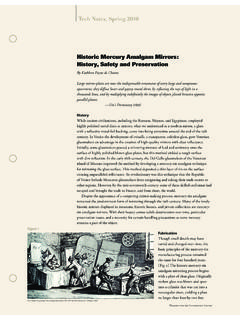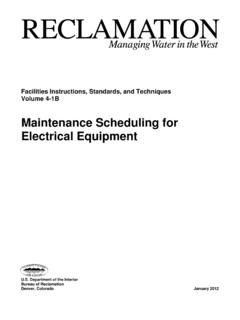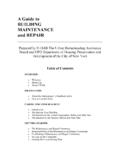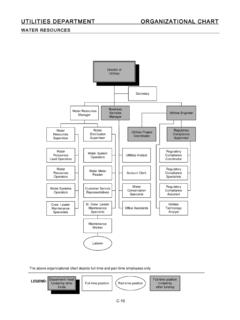Transcription of Annual Maintenance Programs for Outdoor …
1 1 Williamstown Art Conservation Center Technical BulletinAnnual Maintenance Programs for Outdoor SculptureMaintaining Outdoor sculptures can be a very challenging problem for conservators, curators and collectors alike. Outdoor artworks are frequently very large in scale, and for design reasons may often be installed in inaccessible locations (such as reflecting pools or tall pedestals). Exposure to extremes of weather, and to continued public contact, causes degradation and damage to occur more quickly than for most other art collections. These factors combine to make conservation of Outdoor works both frequently necessary and very costly. Unfortunately, the high cost of Outdoor sculpture Maintenance is often unanticipated by the owners. Decisions to exhibit public monuments and Outdoor works are made through a variety of channels (during an architectural expansion, perhaps, or through veterans groups or arts committees), and often without consulting museum professionals.
2 Ideally, the hidden costs of Outdoor sculptures should be evaluated prior to acquisition, and again before installation. Often, Maintenance costs could be much reduced by choosing more durable materials or practical locations; all too often these realizations come too late. Take a Proactive Approach As with all art, preventive care is the best defense. Preservation plans for Outdoor sculptures should always include a schedule of regular Maintenance , including inspections and documentation of condition, periodic cleaning and minor conservation. Minor touch-ups can keep a sculpture looking its best between major treatment campaigns, and Annual inspections can catch small problems before they become big ones. Outdoor sculpture exists in the public forum, and provides countless opportunities for arts education. It follows that a good Annual Maintenance plan can make the most of local participation.
3 Publicizing the goals of a Maintenance program also helps to discourage vandalism. Community volunteers and student assistance promote arts awareness as well as mitigate costs. Maintenance Programs can be more reliable and cost-efficient if they rely on in-house staff, rather than on outside contract conservators. Even minimal washing and waxing can be time-consuming and expensive on a per-hour rate. The weather may cause delays, and other public events often conflict. Counting on a visiting conservation team to complete a comprehensive cleaning program in one tightly-scheduled visit may be impractical. Instead, museum staff may find it more realistic to plan periodic work days (or work weeks) for cleaning on a flexible schedule, spaced throughout the summer months. Conservation expertise is a necessary component of any Maintenance program, of course, and an efficient program will use that expertise to the best advantage.
4 An efficient method may be to have a conservation team spend several days on-site at the beginning of the summer, to help launch the program, make initial assessments of the sculptures, and to provide expert assistance. Once underway, conservator participation can be limited to briefer visits, telephone consultations, and major treatments. 2 General Maintenance Procedures Documentation is an important first step in any conservation Maintenance program. One useful method for record-keeping is to create a loose-leaf binder containing separate indexed entries for each sculpture. Images and diagrams, Annual Maintenance logs, and an initial thorough examination can be kept in each section for easy reference. For most sculptures, an Annual Maintenance program should include regular washing with light hose pressure, using a dilute solution of mild detergent in water1 followed by water rinse.
5 Use soft, nylon bristle brushes or sponges to apply the Proper washing and wax Maintenance will also provide the opportunity to examine the sculpture closely. Changes in surface patina, pitting/streaking or other evidence of corrosion, blanching, structural problems or damage should be documented. The environmental conditions surrounding an Outdoor sculpture can affect its condition. Encroaching vegetation, which may encourage bird, animal, and vandal activity, should be cleared. Weep holes in the sculpture should always be kept clear to allow water drainage. Protective roofing or enclosures should be considered for the winter months in colder climates. Whenever possible, discourage the public from touching or climbing on Outdoor sculptures. Applied surface coatings are easily scratched, and will be worn away by excessive handling.
6 Natural barriers such as landscaping ( , plants or gravel to discourage skateboarders and bicycles), adequate lighting at night, and security patrols can reduce the need for expensive repairs. Maintain protective coatings for Outdoor sculpture. Many sculptures, especially metal ones, can benefit from using sacrificial protective coatings. An inert, transparent coating is applied over the finished sculpture, which can be removed (without damaging the art-work below) and replaced as it becomes dirty or worn. Regular application and renewal of protective coatings can be cost-effective means of prolonging the life of the sculpture, since they are much less intrusive and less expensive to replace or adjust than are the artist s original is a common, easy and effective choice for protecting metals and other materials both indoors and out.
7 It is used on most bronzes and on some painted sculptures. Wax can be tinted, and hardness can be adjusted by mixing waxes of different molecular weights. Protective wax coatings are inexpensive and easily reversible, but are not as durable as harder resins or varnish coatings. Wax coatings should be renewed regularly (once or twice a year depending on conditions). Application of wax is a relatively safe and simple process, and can be carried out by the owner or a staff member with basic training. A hard, transparent, paste wax3 should be applied thinly and evenly or excess wax will build up, collect foreign airborne debris, and blanch (turning white or light gray) with time. Multiple thin coats of hard wax, compacted by buffing, are preferable to a single, thick application, making it more labor intensive than other coatings.
8 In some cases, a coating harder and more durable than wax may be needed. A mirror-bright finish may require greater protection, for example, or a sculpture s inaccessible site could make Annual Maintenance too difficult. Acrylic resins, developed for Outdoor use, are typically recommended in such Unlike wax, resins coalesce as they cure to form a water-impermeable barrier. Resins can also contain useful additives such as ultraviolet light absorbers or graffiti-releasing agents, and can be appropriate coatings for painted polychrome sculptures as well. Acrylic resins can be more time-consuming and difficult to apply than wax. Resins often contain hazardous organic components (such as toluene), and so should be applied by trained professionals with appropriate safety controls in place. Resins form 3a cohesive film, linked on a molecular level, which can flake or peel in an unsightly manner when it begins to degrade.
9 Thus, renewal of such coatings must be preceded by thorough removal. Incralac acrylic resin is often chosen by conservators as a protective coating for patinated bronze sculptures. Developed by the corrosion engineers and intended for use in the electronics industry,5 Incralac contains a corrosion inhibitor benzotriazole that can help to protect bronze. While offering added protection, Incralac is typically applied in the aromatic solvent toluene, and so needs special safety considerations and conservation expertise. It should only be applied, removed, or otherwise treated under the supervision of a conservator. Like all Outdoor coatings, Incralac may require touching up every few years, and ideally should be renewed overall every ten years or so, depending on environmental conditions. Again, regular Annual Maintenance (and even additional wax layers) can protect the Incralac coating and add years to its lifespan.
10 Summary Outdoor sculpture Maintenance requires permanent, long-term commitment of museum staff and funds. Careful planning and good management can stretch budgets for this necessary, but expensive, aspect of collections care, as can good public education and volunteer Programs . 1. Different surfactants are appropriate for different substrates. For most metal or painted surfaces, one teaspoon/gallon of mild anionic synthetic detergent such as Orvus WA Paste, available from Conservation Support Systems, telephone 800-482-6299, is appropriate. 2. Soft bristle brushes with plastic handle and ferrule for dusting, cleaning and wax application are available from autobody supply companies such as Griot s Garage, telephone:800-345-5789. 3. Such as Butcher s White Diamond paste wax, available at most hardware stores. 4. Historically, natural resins such as shellac, and oils including linseed oil have been used but these are not currently recommended because sunlight exposure and weathering can make removal very difficult.









